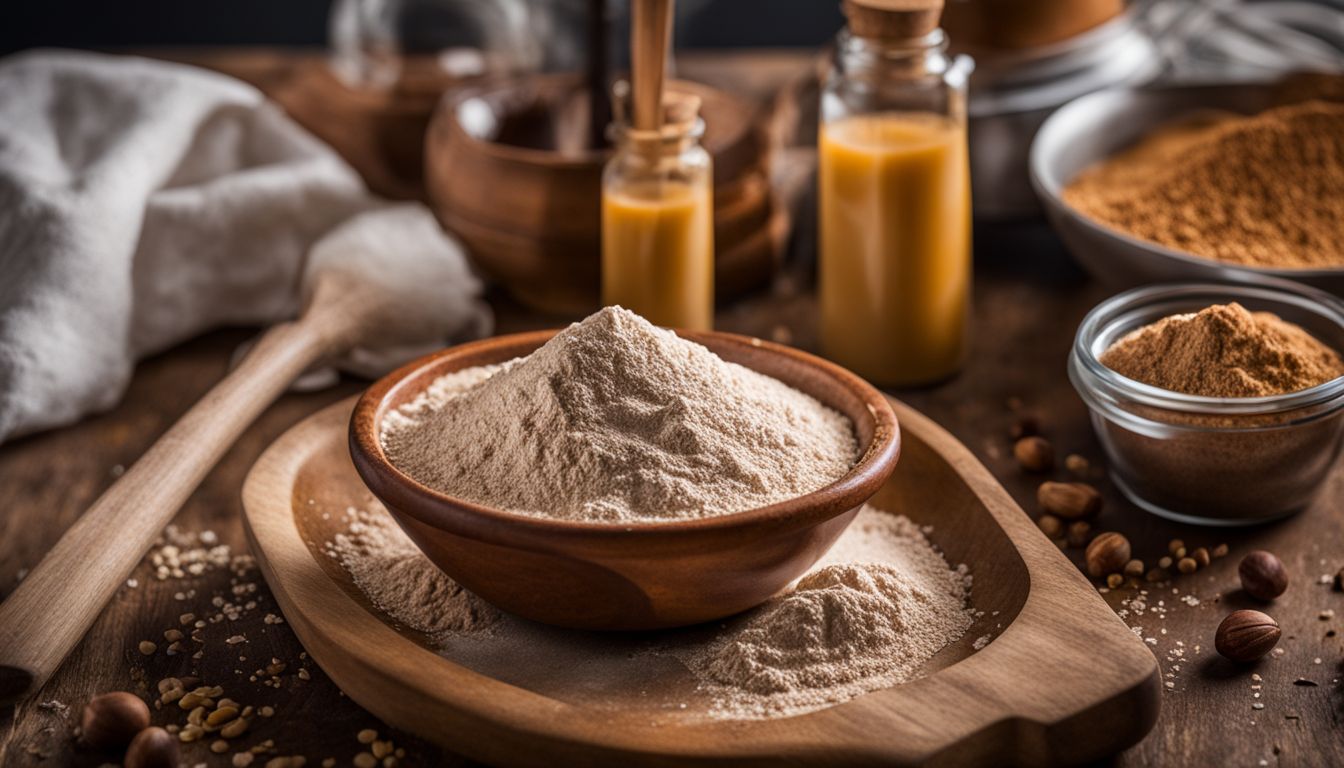Are you trying to enhance your muscle mass or meet your daily protein needs? You’re not alone. Many turn to protein powders as a convenient solution, be it after exercising or as part of a meal replacement in smoothies. Protein powder is an essential nutrient that supports muscle building, helps repair tissues, and can even contribute to weight loss by keeping you feeling full longer.
One interesting fact about the manufacturing process is that protein powder often starts its journey from pasteurised milk before turning into popular forms such as whey or casein.
This article will guide you through how these powders are made, from the sourcing of proteins right up to their transformation into the fine powder we mix into our post-workout shakes. We’ll explore different types and what to consider when choosing one that fits with a healthy diet. Ready for a clearer view on protein powders?
What is Protein Powder?

Protein powder is a concentrated source of protein from various sources such as milk, plants, or animals. The purpose of protein powder is to provide an easily consumable form of high-quality protein that can be used for muscle repair and growth.
Definition
Protein powder is a dietary supplement created to boost protein intake in the diet. It comes from various sources, including dairy products like milk and cheese, as well as plant-based options such as yellow peas and soybeans.
This powder serves as an easy way for people to get essential amino acids their bodies need for muscle growth, repair of cellular structures, and maintaining healthy bones.
The creation of this supplement involves pasteurising milk to make popular types like whey and casein protein powders. During production, enzymes prompt the milk to curdle, separating the solid parts from the liquid whey in cheese-making or directly extracting the casein protein.
High-quality ingredients are vital since some powders may contain heavy metals that pose health risks. Every batch undergoes strict quality and safety screenings to ensure it’s free from toxins and contaminants before reaching consumers.
Check out the great protein debate.
Purpose
Protein powder serves a crucial role in meeting daily protein needs, especially for those who might not get enough from their diet alone. It helps build muscles, supports physical activity recovery, and aids in maintaining lean body mass.
For vegetarians or vegans, finding high-protein foods that match the effectiveness of animal products can be challenging. Protein supplements like whey and pea protein offer a convenient solution.
They fill the gap by providing essential amino acids necessary for muscle repair and growth.
Manufacturers design these powders to support various health goals. Whether it’s increasing muscle strength, aiding weight loss, or simply ensuring adequate dietary protein intake, there’s a product suited to different needs.
People with higher protein requirements due to active lifestyles or specific dietary choices find these powders particularly beneficial. They make reaching daily nutritional targets easier without having to consume large amounts of food.
The Process of Making Protein Powder

To make protein powder, manufacturers first extract proteins from various sources such as whey, casein, soy, and pea. Then they concentrate and purify the proteins to create different types of powders.
Sources of protein
Protein powder begins its journey from a variety of sources. Dairy products, such as pasteurised milk, serve as the primary foundation for whey and casein proteins. These proteins form when special enzymes make the milk curdle, a crucial step in separating these two protein types.
Plant-based options come from yellow peas, soybeans, and hemp seeds. Each source offers unique nutritional benefits, including essential amino acids like leucine that are vital for muscle building.
Animal sources include lean meats like chicken breast and turkey breast; seafood also contributes high-quality protein. For those following a vegetarian diet, chickpeas, black beans, nuts and seeds provide both protein and fibre.
Foods such as quinoa even offer a complete set of amino acids similar to animal proteins. High-protein dairy foods like Greek yoghurt and cottage cheese not only add variety but are excellent for those looking to increase their intake of calcium alongside their protein consumption.
Extraction of protein
To extract protein, workers first add enzymes to pasteurised milk. This step causes the milk to curdle, separating it into solid and liquid parts. The solid part forms cheese or casein protein, while the remaining liquid contains whey protein.
This separation is crucial for obtaining different types of protein powders.
Next, they use enzymatic activity to further refine these proteins. For whey protein, this involves taking the liquid left from cheesemaking and processing it to increase its protein content.
Each type of enzyme has a specific role in breaking down the components, which helps isolate the desired proteins like leucine that are key for muscle building and repair. Through these steps, manufacturers can ensure their products meet high-protein foods standards while also adhering to dietary guidelines.
Concentration and purification
After the initial extraction of protein, the next critical steps are concentration and refinement. This process involves removing unwanted substances such as fats, carbs, and possible toxins to enhance the purity of the protein.
Specialists use techniques like microfiltration or ultrafiltration to concentrate protein from its source material. These methods work by forcing the liquid part of a mixture through a membrane that catches larger molecules like protein while letting smaller ones pass through.
Once concentrated, purification further enhances quality. This is done using ion exchange chromatography, where proteins bind to charged columns based on their ionic properties and unwanted components are washed away.
The result is a highly purified product with minimal contaminants, including heavy metals like lead, arsenic, and cadmium which can be harmful if consumed in large amounts. Quality screening ensures that each batch of protein powder meets strict safety standards before it moves on to become various types of protein powders such as whey or casein.
Types of Protein Powders
When it comes to types of protein powders, they are usually classified into different categories such as whey, casein, soy, and pea. A variety of sources are used to create these powders, each designed to enhance specific dietary or fitness needs.
Whey
Whey protein comes from milk during the cheese-making process. First, enzymes are added to pasteurised milk which causes it to curdle, separating the solid parts from the liquid whey.
This liquid is then further processed to become the powder we use for muscle building and repair. It contains all essential amino acids, making it a complete protein source vital for our bodies.
This type of protein is particularly rich in leucine, an amino acid crucial for protein synthesis and helping prevent muscle loss or sarcopenia as we age. Fitness enthusiasts and athletes often choose whey protein for its effectiveness in supporting recovery after exercise.
Its high-quality amino acid profile makes it an excellent choice for boosting daily protein intake recommendations, contributing significantly to overall health and physical performance.
Casein
Shifting focus from whey, casein protein emerges as another vital player in the protein powder game. It’s derived by separating the solid components from milk, effectively leaving behind the liquid whey.
This process taps into the rich reserves of essential amino acids found in dairy products, offering a slow-releasing protein source ideal for muscle recovery and growth.
Unlike its counterpart whey that quickly assimilates into the body, casein digests at a leisurely pace. This makes it perfect for providing a steady stream of amino acids to muscles over several hours, making it highly sought after for nighttime consumption or periods of fasting.
With its unique ability to facilitate gradual protein absorption, casein stands out as an indispensable component of high-protein diets aimed at enhancing muscle repair and building while you rest.
Soy
Soy is a common source of protein powder and is derived from soybeans. The process involves extracting the protein by grinding soybeans into a fine powder and then separating the protein from other components such as fiber and carbohydrates.
Soy protein isolate, made from defatted soy flour, undergoes further processing to remove non-protein components, resulting in a highly concentrated form of soy protein. This type of protein powder provides all essential amino acids necessary for human health and is known for its high nutritional value.
Soy-based protein powders are popular among individuals seeking plant-based alternatives to animal-derived proteins. They offer benefits such as supporting muscle growth and repair due to their rich content of branched-chain amino acids like leucine, isoleucine, and valine.
Additionally, soy contains compounds with potential health-promoting properties such as antioxidants that help combat cellular damage caused by free radicals. As an alternative to animal-sourced proteins, soy-based powders play a crucial role in providing diverse options for individuals with specific dietary requirements or preferences.
Pea
Pea protein powder is another popular plant-based protein source. It is derived from yellow peas and is often used as an alternative to animal-based powders for those with dietary restrictions, such as lactose intolerance or veganism.
Pea protein is rich in essential amino acids, making it a complete protein source that can support muscle growth and repair. Additionally, pea protein powder is known for its high digestibility and low allergenic potential, making it suitable for individuals with sensitive stomachs or allergies to other types of proteins.
In addition to being a sustainable and environmentally friendly option, pea protein also offers health benefits such as promoting satiety and aiding weight management.
Pea protein can be obtained by milling dried peas into a fine flour and then isolating the proteins through processes like wet extraction or dry fractionation. The resulting powder contains around 80-90% pure protein which makes it comparable with whey products.
This makes pea one of the most sought-after plant-based alternatives in the ever-growing market of nutritional supplements thanks to its versatility and numerous health benefits.
Pros and Cons of Protein Powder
Protein powders offer a convenient way to increase protein intake, which is beneficial for muscle growth and repair. However, some individuals may experience digestive discomfort or allergic reactions when consuming certain types of protein powder.
Benefits
Protein powder offers numerous benefits, facilitating muscle recovery and growth, aiding weight management, and supporting overall health. It provides a convenient source of high-quality protein for individuals with active lifestyles or limited time to prepare meals.
Additionally, some protein powders contain essential amino acids necessary for various bodily functions. With careful selection and consumption within recommended guidelines, these products can be a valuable addition to an individual’s dietary regimen.
When choosing a protein powder specifically focused on enhancing muscle repair and growth or supporting general health goals such as weight management or improved nutrition levels; it is important to consider product quality alongside individual preferences.
Next – Potential drawbacks
Potential drawbacks
While protein powder offers numerous benefits, it’s essential to be aware of potential drawbacks when considering its use. One concern is the possible presence of heavy metals like lead, arsenic, and cadmium in some protein powders, which can pose health risks if consumed in excessive amounts over time.
Moreover, certain individuals may experience digestive issues such as bloating or discomfort due to intolerance to specific protein sources commonly found in powder form. It’s crucial for consumers to carefully examine labels and select products made from high-quality sources that have undergone rigorous safety screening processes.
Ensuring that the chosen protein powder is free from toxins and contaminants is imperative for safeguarding one’s health and well-being. Additionally, being mindful of individual dietary restrictions or sensitivities is vital before incorporating any type of protein powder into a daily regimen.
By staying informed about these potential concerns, consumers can make informed decisions related to their dietary choices while maximising the benefits of this nutritional supplement.
Considerations when choosing a protein powder
When choosing a protein powder, it is crucial to consider the source of the protein. Different types of protein powders, such as whey, casein, soy, and pea, have varying nutritional profiles and amino acid contents.
It’s vital to check for heavy metal contamination in the product due to potential health risks associated with lead, arsenic, and cadmium. Moreover, ensuring that the milk used is from high-quality sources and passes safety tests are essential considerations when selecting a protein powder.
In addition to considering the source of the protein and screening for heavy metal contamination and quality assurance checks on the milk used before enzymes are added for separation of whey and casain proteins highlight important factors when choosing a suitable protein powder.
Next Heading: “Pros and Cons of Protein Powder
Conclusion
Protein powder is made from pasteurized milk, and common types include whey and casein protein powders. Enzymes are added to make the milk curdle in the process of making protein powder.
The milk must pass quality tests before enzymes separate whey and casein proteins. Protein powders can also be sourced from dairy, egg whites, yellow peas, soybeans, and hemp seeds.
It’s important to ensure that the product is made from high-quality sources and does not contain harmful substances. The process involves screening for quality and safety to ensure it’s free from toxins and contaminants.
FAQs
1. What is protein powder?
Protein powder is a high-protein food made from animal or plant sources. It helps your body build muscles and fight off diseases.
2. How do we get protein powder from foods like fish and soy products?
First, we take high protein foods such as fatty fish, lean beef, and soy products. Then, through a process of extracting proteins and drying them into a fine powder, we create protein powder.
3. Why are amino acids important in making protein powder?
Amino acids are the building blocks of proteins. They link together in specific sequences to form different proteins that our bodies need for tasks like cell signalling and repairing tissues.
4. Can eating protein powder help prevent diseases?
Yes! Protein powders contain essential amino acids that support your immune system by helping produce antibodies which fight off illnesses.
5. How does the structure of proteins affect their function in our bodies?
The three-dimensional structure of a protein determines how it works in our bodies, whether it’s speeding up chemical reactions or sending signals between cells.
6. What role do enzymes play in producing protein powders?
Enzymes break down the proteins from food sources into smaller parts called peptides during production, making it easier for our body to use when consumed as a supplement.





